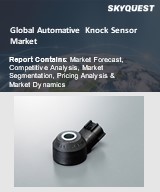
Product ID: SQMIG45O2043

Report ID:
SQMIG45O2043 |
Region:
Global |
Published Date: April, 2024
Pages:
220
|
Tables:
62 |
Figures:
70
Global Automotive Knock Sensor Market size was valued at USD 787.47 million in 2022, USD 862.99 million in 2023 and is projected to grow USD 1795.45 million by 2031, growing at a CAGR of 9.59% in the forecast period (2024-2031).
An internal combustion engine's cylinder head or engine block is where the automotive knock sensor is mounted. It is employed to identify knocking sounds coming from an automobile engine's combustion chamber. Piezoelectric components, which make up knock sensors, provide an electric signal in response to detonation-induced vibrations. Whenever there is a spark knock, the engine uses this signal to delay timing. To detect vibrations brought on by engine knock or detonation, the automotive knock sensor is housed in the intake manifold, cylinder head, or lower engine block. The engine's life cycle is shortened by engine knocking, which can occasionally result in engine failure. The engine's longevity will enhance with the detection and mitigation of knocking.
Over the projected period, the automotive knock sensor market will be driven by rising demand from passenger cars and commercial vehicles. Demand is expected to increase throughout the planning horizon due to factors that contributed to the development of an affordable autonomous car detector and increased public funding from many sources for detectors. However, software bugs and expensive vehicle and infrastructure costs could restrict the market's expansion. Furthermore, alliances and collaborations between different automakers, including LiDAR vendors, may create new opportunities in the automotive commercial vehicle sensing sector. Several governments have promoted the use of technology in vehicles to protect their residents' safety.
Our industry expert will work with you to provide you with customized data in a short amount of time.
REQUEST FREE CUSTOMIZATIONWant to customize this report? This report can be personalized according to your needs. Our analysts and industry experts will work directly with you to understand your requirements and provide you with customized data in a short amount of time. We offer $1000 worth of FREE customization at the time of purchase.

Product ID: SQMIG45O2043